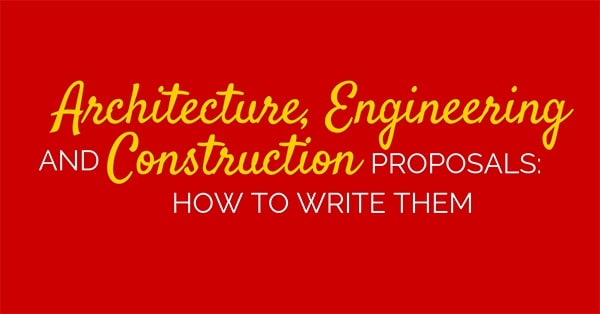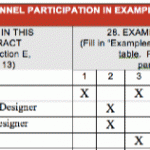
Every day, thousands of people are hard at work writing (and managing the efforts) for architecture proposals, engineering proposals, or construction proposals. In this post, I want to dive into some of the nuances you might encounter while writing proposals for the AEC industry.
What Is The AEC Industry?
What do I mean when I say “AEC industry?” AEC (or A/E/C) refers to the architecture, engineering, and construction industry. Sometimes, people just refer to this as the “construction industry.”
When Do You Need To Write An Architecture, Engineering, or Construction Proposal?
In this industry, opportunities to propose come in two general ways. First, you might meet with a client and they ask you to send in a proposal. Typically, this is referred to as a “letter proposal” because your proposal response is often in the form of a letter.
The larger proposal efforts are usually in response to an RFP (request for proposal). An RFP is a formal document that outlines the rules for submitting a proposal. When submitting a proposal in response to an RFP, you can be nearly certain that you are competing with other firms for the contract.
Sometimes you’ll be writing a proposal for one specific service. But sometimes, you’ll be writing an architecture and engineering proposal in the same effort. There are also instances when you’ll be writing what’s known as a “design-build” proposal. In this case, you’ll be proposing architectural, engineering, and construction services at the same time.
The Steps Of A Proposal Competition (Procurement)
But wait a minute Matt, my clients ask for a “letter of interest” or “statement of qualifications.”
That’s not uncommon.
Often, the process needed to procure services requires multiple steps. After each step, buyers will reduce the pool of providers (which is often referred to as “shortlisting” or “long listing.”)
For example, to even consider working for some clients you’ll have to go through a “prequalification process.” That process will determine whether your firm has the minimum qualifications and experience to work (on any project) with this client.
Then you might be asked to submit a “letter of interest” or “statement of qualifications.” In these documents, you’re often asked to describe why your qualifications and team are perfect for this particular project.
After these are submitted, there will typically be some sort of list made of the providers that are going to the “next step.” The next step is often referred to as a “technical proposal.”
There may be a separate, more detailed RFP in this next step. You may or may not be asked to provide pricing at this point. But you’ll likely be asked about your approach to completing the scope of work. This is referred to as a “technical approach.”
You’ll likely be asked to provide lots of other information, including additional information about your qualifications and team.
If you are asked to provide pricing in this “second step,” it’s often asked for in a “separately sealed envelope.” This means your pricing information is sent along in the same box as your proposal. It’s just provided in a separate, sealed, envelope.
Clients often do that because they score the technical and price elements separately.
If there is a final step, it’s usually what’s known as a “shortlist presentation.” Sometimes you’ll be asked to provide pricing documentation when you go in for your shortlist presentation. Typically, they narrow down shortlist presentations to three to five firms.
If thirty firms submit on an RFP, it is easy to see why clients have these complex processes to whittle the field down to three to five firms.
In the world of IDIQ (Indefinite Delivery Indefinite Quantity) or “On-Call” contracts, they may whittle it down to 30 proposers and award five to fifteen contracts. Then there is another proposal process where those 15 firms compete for “task orders” (i.e. assignments).
Each client will have a different procurement process. That’s why I’m saying “likely” and “often.” You’ll be hard pressed to find two clients with identical procurement processes.
So, don’t get confused with the terminology. Just make sure you provide what the RFP (or request for qualifications or request for letters of interest) asks for. And make sure you take the time to understand each client’s process for procuring your services. I often refer to this as the “game being played.”
How Architecture, Engineering, and Construction Proposals Differ
While each of these entities help build projects, architecture, engineering, and construction firms are inherently different. And in some ways, their proposals are going to be different.
Let me give you some examples.
Architecture firms often spend a good deal of their marketing budget on photography. Visuals are very important when selling architecture. You’ll likely see more high-end project photography in architecture proposals.
In contrast, visuals are not as critical to selling the services of a mechanical/electrical/plumbing engineer. You might have a nice photo of a boiler or some huge underground piping. But at the end of the day, clients don’t say, “We’ve got to go with this MEP firm because they have the sexiest looking toilets, fire suppression systems, and air ducts.”
Of course, there are many kinds of engineers. Photography might be a critical component for a proposal to design a bridge. But for the most part, you’ll see more emphasis on project visuals from an architecture firm’s proposal.
When it comes to actually building a project, process is critical. Therefore, you’re likely to see more flow charts, schedules, and diagrams in proposals from construction firms. You’ll also probably see more photos of project meetings and the firm implementing the process.
While the visual elements in the proposals may be different, how you write proposals can and should be consistent regardless of the type of firm you are writing for.
The Structure of An AEC Proposal
There is a lot that goes into the structure of your proposal. Many times, the structure will be dictated by the RFP you are responding to.
However, certain sections are common in most proposals.
- Cover Letter/Executive Summary – This is where you make your case.
- Project Understanding – Here we describe the problem and prove to the reader that we have a complete understanding of it.
- Relevant Experience – Hopefully, you’ve done it before. This is the section where you outline how you’ve done it and who you’ve done it for.
- Team Resumes – Somebody has to do the work. So, in this section you’ll introduce them to your team.
- Technical Approach – They will want to know how you will do the work. In this section, we describe how we will do it and why we will do it that way.
- Management Plan – We’ll explain how we are going to manage this assignment. People often skip over this proposal section. But really, it is very important.
- Pricing – Oh, the dreaded pricing. In this section, we’ll tell them how much this is going to cost.
I go into great detail about how to write each section in Proposal Structure: The Sections Your Proposal Will Need
That’s a helpful proposal writing resource you’ll want to read.
How To Write An Architecture, Engineering, or Construction Proposal
Although things like architectural services can be visual in nature, you’ll still have to persuade your audience using the written word.
Whether you are a good writer or not, there are several proposal writing best practices you’ll need to adhere to. I’ve outlined seven rules you should follow here: How To Write A Good Proposal – Proposal Writing Basics
Once you have the basics down, you’ll want to try using my proposal writing formula. You can learn it here: Proposal Writing Format – My Proposal Writing Formula
That’s what you need to know about writing proposals in the AEC industry.
Feel free to post specific questions in the comments below.
Read The Other Sections Of My Ultimate Guide To Proposal Writing
The article you just read is one section of my Ultimate Guide To Proposal Writing.
Click on the links below to read the other parts.
- Part One: Proposal Writing Basics
- Part Two: The Proposal Structure
- Part Three: The Proposal Writing Formula
- Part Four: The 3 Golden Rules Of Proposal Design
- Part Five: Proposal Templates: What You Need To Know
- Part Six: Architecture, Engineering, and Construction Proposals: How To Write Them





[…] Part Six: Architecture, Engineering, and Construction Proposals: How To Write Them […]